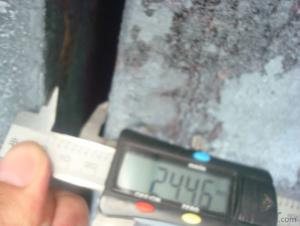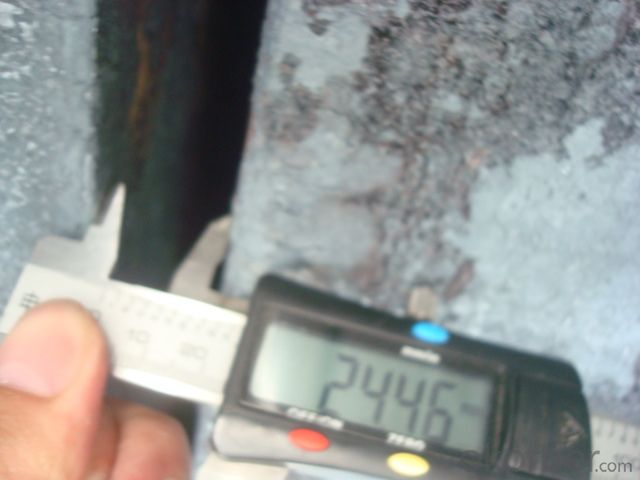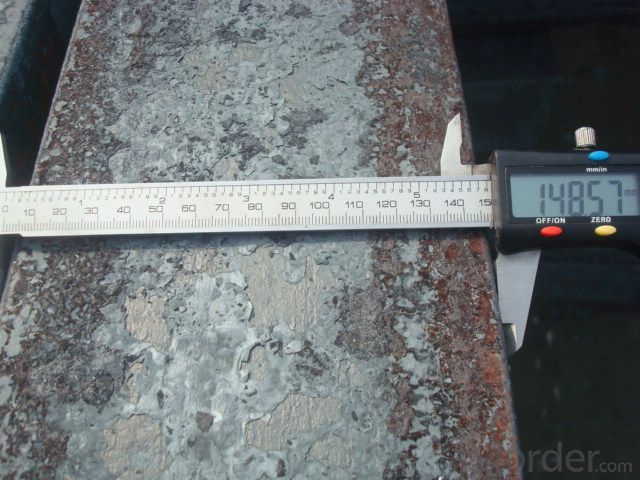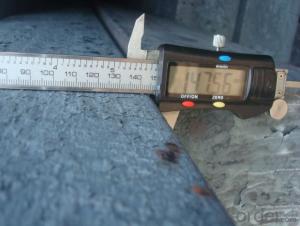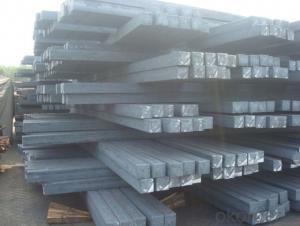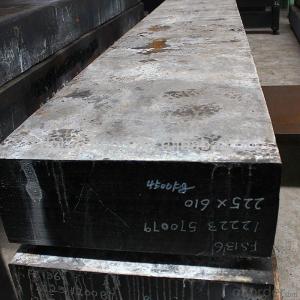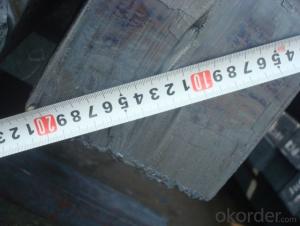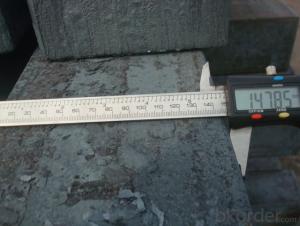Steel Bloom/Billet by Continue Casting Manufactured by Blast Furnace
- Loading Port:
- Tianjin
- Payment Terms:
- TT OR LC
- Min Order Qty:
- 1000 m.t.
- Supply Capability:
- 10000 m.t./month
OKorder Service Pledge
OKorder Financial Service
You Might Also Like
Steel Bloom/Billet by Continue Casting Manufactured by Blast Furnace
1.Structure of Steel Bloom/Billet by Continue Casting Manufactured by Blast Furnace
Steel Billets Manufactured by Continue Casting is the raw material of all kinds of steel mill. Billet section of square, round, flat, rectangular and abnormity, etc Several, mainly related to shape of rolled products. Simple rolled section steel, choose cross section of square billet or rectangular billet. rolling The sector products such as flat steel, Angle steel, select the rectangular billet or slab. Had better profiled billet when production beams, channels, and in rolling process Lines and improve the yield. The raw material of round billet is the production of seamless tube.
2.Main Features of Steel Bloom/Billet by Continue Casting Manufactured by Blast Furnace.
Steel Billets Manufactured by Continue Casting section size should meet the requirements of rolling deformation and finished product quality, but also roll strength and biting condition of restrictions. General steel Billet section height H. And the roll diameter D The ratio of the ( namely H/D) Should be less than or equal to zero 0.5 . Length of steel billet by finishing temperature, Rolling time and the length of the product Or times ruler. When heated too long accident prone to bump the furnace wall of steel, too short, furnace bottom utilization rate is not high, influence the heating furnace production. For the production Choose a variety of steel and steel billet, should consider the affinities of billet, as far as possible in order to improve the productivity of the roughing mill, simplify the stock management of workshop.
3. Steel Bloom/Billet by Continue Casting Manufactured by Blast Furnace Images
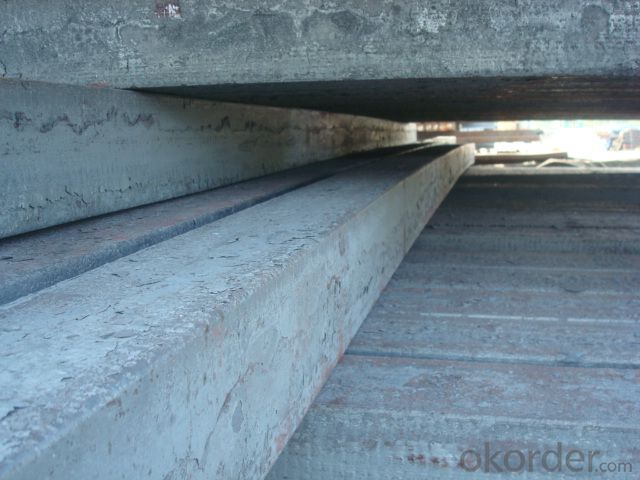

4. Steel Bloom/Billet by Continue Casting Manufactured by Blast Furnace Specification
Steel Bloom/Billet Manufactured by Blast Furnace rolled steel, after processing can be used for mechanical parts, forging parts, processing all kinds of steel, steel Q345B channel steel, wire rod is the role of the billet. Steel billet is used in the production of semi-finished products, generally cannot be used directly for the society. Steel billets and steel are strictly divided into standard, cannot decide to whether the business enterprise of the final product, and according to unified standards to perform the whole society. Typically, billet and the steel is relatively easy to distinguish, but for some steel billet, and have the same specification and same steel purposes (such as rolling tube billet), whether can be used for other industries, whether through steel processing process, whether through a finished product rolling mill processing to distinguish
5.FAQ of Steel Bloom/Billet by Continue Casting Manufactured by Blast Furnace
We have organized several common questions for our clients,may help you sincerely:
①How about your company?
A world class manufacturer & supplier of castings forging in carbon steel and alloy steel,is one of the large-scale professional investment casting production bases in China,consisting of both casting foundry forging and machining factory. Annually more than 8000 tons Precision casting and forging parts are exported to markets in Europe,America and Japan. OEM casting and forging service available according to customer’s requirements.
②How to guarantee the quality of the products?
Slab surface defect is mainly depends on the solidification process of molten steel in mould, its shell in the mould forming process, mould liquid level fluctuation, the submerged nozzle design, protective slag performance and other factors.Must control the parameters affecting the quality of the surface within the target value, thus producing zero defect of slab, which is the precondition of hot delivery and direct rolling. Slab internal defects including internal cracks, porosity and shrinkage cavity, mainly depends on the slab cooling process in secondary cooling area and slab support system.Reasonable secondary cooling water distribution, backup roll for, prevent slab such as drum belly is the premise to improve internal quality of slab.Slab internal elements segregation, which is related to the whole process. , therefore, in order to obtain good casting quality can according to the different requirements of steel grade and products, in the different stages of continuous casting, such as the ladle, tundish, mold and secondary cooling zone using different techniques, including electromagnetic stirring, effectively control the quality of casting billet.
③What is the advantage of the continue Casting steel billet comparing to the die casting steel billet?
Compared with die casting, continuous casting has the advantages of: 1. To simplify the Steel billet The production process 2. Improve the metal yield 3. Improve the quality of the billet 4. Reduces the steel worker's labor intensity 5. Save energy and reduce consumption
- Q: What are the environmental impacts of steel billet production?
- Steel billet production, being a process that yields semi-finished steel products, can have diverse consequences on the environment. One notable impact is the release of greenhouse gases during the manufacturing of steel. This occurs when iron ore is melted, emitting carbon dioxide (CO2) into the atmosphere. CO2 is a significant contributor to global warming and climate change. Another environmental effect of steel billet production is the consumption of natural resources. The steel industry requires substantial amounts of water and energy to manufacture billets. The extraction and processing of raw materials like iron ore and coal can also cause the destruction of habitats and disruption of ecosystems. Moreover, the production of steel billets can lead to pollution of both air and water. Burning fossil fuels during the manufacturing process releases various pollutants, including sulfur dioxide (SO2) and nitrogen oxides (NOx), which contribute to acid rain and respiratory issues. Additionally, the discharge of wastewater from steel production can contain heavy metals and other contaminants, polluting rivers and harming aquatic life. Steel billet production also generates solid waste, such as slag and dust, which present waste management challenges. These waste materials may contain toxic substances, necessitating proper handling and disposal to prevent environmental contamination. Several measures can be taken to alleviate the environmental impacts of steel billet production. The adoption of cleaner technologies, such as energy-efficient furnaces and recycling processes, can help reduce energy consumption and emissions. Implementing rigorous environmental management systems and investing in pollution control technologies can also minimize air and water pollution. Additionally, promoting the use of recycled steel and sustainable sourcing of raw materials can aid in conserving natural resources and reducing the environmental footprint of steel billet production.
- Q: If the casting speed is not steady, what will happen to the billet?
- Secondly, the speed of cutting is unstable, and the cut rate will be reduced.
- Q: What is the role of steel billets in the manufacturing of agricultural machinery?
- The manufacturing process of agricultural machinery relies heavily on steel billets, which are semi-finished steel products cast into a rectangular shape. These billets serve as the raw material for various components and parts. The utilization of steel billets presents numerous advantages in the production of agricultural machinery. Firstly, steel's exceptional strength and durability make it an ideal material for heavy-duty machinery that operates under harsh conditions. By starting the manufacturing process with steel billets, the final products acquire the necessary strength and durability to withstand the demands of agricultural activities. Moreover, steel billets offer versatility in design and fabrication. Agricultural machinery requires components of different shapes and sizes, and steel billets can be easily molded and machined to meet these requirements. This flexibility allows manufacturers to produce complex parts that are crucial for the efficient operation of agricultural machinery. Additionally, steel billets ensure consistent and reliable quality. The manufacturing process of steel billets adheres to strict quality control measures, ensuring uniformity and compliance with industry standards. This consistency in quality translates into reliable performance and longevity of agricultural machinery, reducing the need for frequent repairs or replacements. Furthermore, steel billets possess excellent resistance to corrosion and wear, which is vital for agricultural machinery exposed to various environmental elements. Using steel billets guarantees that the final products can endure exposure to moisture, chemicals, and abrasive materials commonly encountered in agricultural settings. To sum up, the strength, durability, versatility, consistent quality, and resistance to corrosion and wear make steel billets indispensable in the manufacturing of agricultural machinery. By employing steel billets as the raw material, manufacturers can produce agricultural machinery that meets the demanding requirements of the industry, ensuring reliable and efficient performance in various farming applications.
- Q: How are steel billets prepared for further processing?
- Steel billets are prepared for further processing through a series of steps, which include heating the steel to a specific temperature, followed by hot rolling to shape it into desired forms.
- Q: How can the quality of steel billets be improved?
- There are several methods and techniques that can be employed to improve the quality of steel billets. Below are some approaches that can assist in enhancing the quality of steel billets: 1. Raw Material Selection: The quality of steel billets heavily relies on the selection of raw materials. Opting for high-quality raw materials, such as top-grade iron ore and scrap metal, can considerably enhance the quality of billets. 2. Melting and Refining: The melting and refining process play a pivotal role in enhancing steel billet quality. The utilization of advanced melting practices, like electric arc furnaces (EAF) or induction furnaces, can aid in achieving a more uniform and controlled melting process, reducing impurities, and achieving the desired chemical composition. 3. Deoxidation and Degassing: It is essential to employ appropriate deoxidation and degassing techniques to eliminate impurities and gases from the molten metal. This can be accomplished by incorporating suitable deoxidizers and utilizing vacuum degassing processes that efficiently remove unwanted gases, thus enhancing the quality of steel billets. 4. Continuous Casting Process: The implementation of a modern continuous casting process can significantly improve the quality of steel billets. Continuous casting ensures a more consistent structure, reduces segregation, and minimizes the formation of defects commonly associated with traditional ingot casting methods. 5. Heat Treatment: The application of suitable heat treatment processes, such as annealing, quenching, and tempering, can further enhance the mechanical properties and overall quality of steel billets. Heat treatment helps refine the microstructure, improving the strength, hardness, and other desired characteristics of the steel. 6. Quality Control: A robust quality control system is crucial to ensure the production of high-quality steel billets. Regular monitoring and testing should be conducted throughout the production process to promptly identify and rectify any deviations or quality issues. 7. Skilled Workforce: Employing a skilled and knowledgeable workforce is vital for improving the quality of steel billets. Well-trained technicians and operators can effectively implement various quality improvement techniques and address any production challenges that may arise. By incorporating these methods and techniques, steel manufacturers can enhance the quality of steel billets, resulting in improved mechanical properties, superior surface finish, and increased customer satisfaction.
- Q: What is the average weight of a steel billet?
- The size and dimensions of a steel billet can cause variations in its average weight. Nevertheless, a standard steel billet generally ranges from 1,000 kilograms (2,204 pounds) to 5,000 kilograms (11,023 pounds). These weight ranges are commonly observed in industrial-grade steel billets utilized in diverse manufacturing techniques like forging, rolling, and extrusion. It should be emphasized that the weight of a steel billet can be tailored according to specific necessities and industry norms.
- Q: What is the role of steel billets in the construction of railway stations?
- Steel billets play a crucial role in the construction of railway stations. These billets are essentially semi-finished steel products, typically in a rectangular or square shape, that are used as raw material for various construction purposes. In the context of railway stations, steel billets are primarily used in the fabrication of structural components such as beams, columns, and trusses. These components provide the necessary strength and stability to support the weight of the station building, platforms, and any other structures associated with the station. One of the main advantages of using steel billets in railway station construction is their high strength-to-weight ratio. Steel is known for its exceptional strength, making it an ideal material for supporting heavy loads. By using steel billets, engineers can design and construct railway stations that can withstand the constant traffic and heavy footfall experienced in these public spaces. Additionally, steel billets offer excellent durability, corrosion resistance, and fire resistance, all of which are essential factors in ensuring the long-term safety and structural integrity of railway stations. These properties make steel billets a reliable and cost-effective choice for construction projects where safety and longevity are of utmost importance. Furthermore, steel billets can be easily shaped and fabricated into various sizes and dimensions, allowing for flexibility in design and construction. This versatility enables architects and engineers to create aesthetically appealing and functional railway station structures that meet the specific requirements of the project. Overall, the role of steel billets in the construction of railway stations is to provide the necessary strength, durability, and versatility required for the structural components that support these vital transportation hubs. By using steel billets, railway station construction projects can be completed efficiently, ensuring the safety and comfort of passengers for years to come.
- Q: How are steel billets shaped into rods or wires?
- Steel billets are shaped into rods or wires through a process known as hot rolling. The billets are heated to high temperatures and then passed through a series of rollers, which gradually reduce their size and shape them into the desired rod or wire form. This process allows for precise control over the dimensions and properties of the final product.
- Q: What are the different surface treatments for improved corrosion resistance in steel billets?
- There are several surface treatments commonly used to improve corrosion resistance in steel billets. These include hot-dip galvanizing, electroplating, powder coating, and chromate conversion coating. Hot-dip galvanizing involves immersing the steel billets in a bath of molten zinc, forming a protective zinc coating on the surface. Electroplating uses an electric current to deposit a thin layer of a corrosion-resistant metal, such as zinc or nickel, onto the billet's surface. Powder coating involves applying a dry powder coating to the billet's surface, which is then cured to form a protective layer. Chromate conversion coating is a chemical treatment that forms a thin layer of chromate on the surface, providing corrosion resistance. Each of these treatments offers varying levels of protection and is selected based on the specific requirements and conditions of the steel billets.
- Q: How are steel billets used in the manufacturing of electrical equipment?
- Steel billets are used in the manufacturing of electrical equipment in various ways. One of the main applications is in the production of electrical transformers. Transformers are crucial components in electrical systems as they transfer electrical energy between different voltage levels. Steel billets are used to manufacture the core of transformers, which is responsible for efficiently transferring the electrical energy. The steel billets are first heated and then rolled into thin strips or sheets, which are then cut into specific shapes and sizes to form the core laminations. These laminations are stacked together and insulated to minimize energy losses and ensure efficient power transfer. The use of steel billets ensures the core's strength, durability, and magnetic properties, which are essential for the transformer's functionality. Steel billets are also utilized in the manufacturing of other electrical equipment such as motors and generators. In these applications, the billets are formed and machined into specific components, such as rotor and stator cores, that play a vital role in the generation and conversion of electrical energy. Moreover, steel billets are used in the production of electrical enclosures and cabinets, which protect sensitive equipment and wiring from external factors like moisture, dust, and physical damage. These billets are shaped, welded, and assembled to create sturdy and reliable enclosures that house electrical components. Overall, steel billets are an integral part of the manufacturing process for electrical equipment. Their versatility, strength, and magnetic properties make them suitable for various applications, ensuring the efficiency, reliability, and longevity of electrical systems.
Send your message to us
Steel Bloom/Billet by Continue Casting Manufactured by Blast Furnace
- Loading Port:
- Tianjin
- Payment Terms:
- TT OR LC
- Min Order Qty:
- 1000 m.t.
- Supply Capability:
- 10000 m.t./month
OKorder Service Pledge
OKorder Financial Service
Similar products
Hot products
Hot Searches
Related keywords
